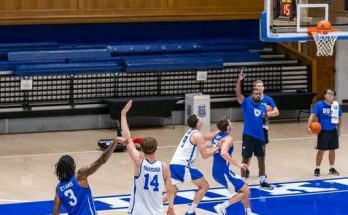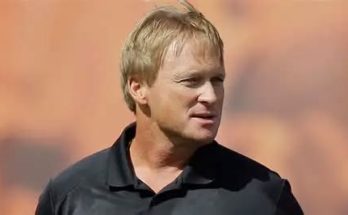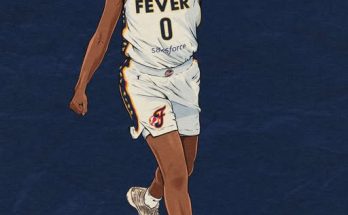There’s a certain level of tension that comes with every NFL training camp—the anticipation of breakout performances, the hope for injury-free sessions, and the constant evaluation of player dynamics. So, when Green Bay Packers running back MarShawn Lloyd left the field following a high-intensity hit from Nate Hobbs, eyebrows understandably raised. The buzz around the play grew quickly. Was it a dirty hit? Was it reckless? And most importantly, did it cause the injury? In the aftermath of swirling speculation, Packers General Manager Brian Gutekunst stepped forward with a clear message: “It probably didn’t cause the injury.” While brief, that statement is already shaping narratives in Green Bay and around the league.
For Gutekunst, this wasn’t just a defensive move to protect a member of his current roster. It was a calculated, deliberate effort to steer the story back to football and away from blame. In a league where every move is scrutinized from multiple angles, the Packers’ front office knows the power of shaping a narrative early. Gutekunst’s comment came during an impromptu media scrum just outside the team’s training facility, and it instantly made headlines. Calm, direct, and firm, his tone carried the weight of someone who’s seen too many summers derail over misinterpreted plays.
From the outset, Hobbs’ hit appeared legal. He didn’t lead with the crown of his helmet, didn’t lunge blindly, and didn’t make contact above the shoulders. It was physical, yes. But by football standards, it was textbook. Even Lloyd, immediately after the play, didn’t seem overly distressed. He walked off under his own power and only later began showing signs of discomfort. That timeline, according to Gutekunst and the Packers’ medical staff, is important. It indicates that the injury could be attributed to cumulative strain, previous soreness, or even a non-contact issue aggravated during or after the collision. But not the hit itself.
Of course, in today’s NFL, perception often overrides fact—at least initially. Clips of the collision began circulating within minutes. Analysts slowed it down, replayed it from multiple angles, and social media added its own brand of wildfire commentary. Accusations of unnecessary aggression and dangerous intent surged through Twitter and Instagram. Nate Hobbs, a player who has long carried a reputation as a hard-nosed but fair defender, suddenly found his name in headlines that questioned his integrity.
Gutekunst’s response wasn’t just about the health of Lloyd. It was also a public show of support for Hobbs. And in a league where locker room unity can make or break a season, those statements matter deeply. Players notice. Coaches notice. And most of all, the narrative outside the building begins to shift. While Gutekunst didn’t downplay the seriousness of the injury, he made it clear that football is a contact sport, and injuries—however unfortunate—are sometimes simply part of the game.
Still, the concern around Lloyd’s status is real. Drafted for his explosive burst and versatility, he’s been pegged by coaches and insiders as a potential X-factor in the Packers’ evolving offense. His ability to catch out of the backfield, break through initial contact, and operate in open space has added a layer of unpredictability to Jordan Love’s options. Any prolonged absence could shift offensive schemes and impact early season momentum. But what Gutekunst made abundantly clear is that this isn’t about assigning blame. It’s about process, medical evaluations, and ensuring that players recover the right way.
Nate Hobbs, for his part, hasn’t spoken much since the play. A few words in passing to reporters—mostly “it’s football” and “hope he’s alright”—have been his only public statements. Sources close to the locker room describe him as “upset but professional,” clearly bothered that a routine play has been interpreted by some as something malicious. He’s known as a grinder, a guy who leaves everything on the field, and those close to the Raiders, his former team, vouched for his character as the story gained traction.
Internally, the Packers have already reviewed the play multiple times. Coaches and staff studied the angles, consulted with league officials, and confirmed that there was no breach of rules. That’s important not just for clearing Hobbs’ name, but also for understanding the nature of injury prevention and player safety at large. The NFL, increasingly concerned with protecting its athletes, mandates such evaluations regularly. But in this case, all signs point to the collision being an unfortunate coincidence rather than a cause.
There’s also the broader implication of trust between players. In training camp, every rep matters. Players compete for roster spots, yes, but they also rely on each other to keep things professional and controlled. When a hit seems excessive or avoidable, even in the heat of the moment, it can fracture relationships and derail chemistry. That hasn’t happened here. According to multiple team sources, Hobbs and Lloyd have spoken since the incident. No animosity. No finger-pointing. Just two professionals navigating the thin line between competition and safety.
Gutekunst’s statement also carries weight in terms of organizational posture. It shows the Packers are not only monitoring health but also media and public perception. By stepping out front, before narratives harden, he’s reminded the NFL world that Green Bay isn’t going to let viral clips drive the story. It’s a smart play from a front office that knows distractions are the enemy of consistency.
As the Packers continue their preseason preparations, all eyes will remain on Lloyd’s health. While the team has other capable backs, the young rookie brought a dynamic edge that coaches were eager to unleash. His injury timetable remains unclear, but early indications suggest it won’t be season-threatening. That’s a relief, and it reinforces Gutekunst’s point: the hit, while impactful, was likely not the culprit.
Of course, this won’t be the last time an in-practice collision becomes a national talking point. The NFL’s intense media ecosystem, combined with fans’ increasing access to real-time footage and analysis, means that every training camp session is potentially a story. For general managers like Gutekunst, that requires not only football knowledge but communication savvy. How and when you speak matters. In this case, the GM played it perfectly—offering clarity without deflection, support without bias.
And yet, for all the analysis, the takeaway remains simple. Football is violent. Injuries happen. Sometimes a player goes down, and there’s no one to blame. Not the opponent. Not the coach. Not even the circumstances. Just bad timing, unfortunate angles, and the grind of a sport that’s as unforgiving as it is exhilarating.
For MarShawn Lloyd, the focus now shifts to recovery. He’ll be watched closely by medical staff, supported by teammates, and gradually worked back into the mix when ready. For Nate Hobbs, it’s about moving forward without carrying the weight of blame that was never his to begin with. And for Brian Gutekunst, it’s about steering a ship through the early tempests of training camp without letting perception drown out reality.
Whether or not Lloyd’s injury slows his momentum remains to be seen. But what’s already evident is that the Packers, from front office to field, are locked in on protecting their players—both physically and reputationally. In a sport defined by impact, it’s that kind of leadership that sets franchises apart.



